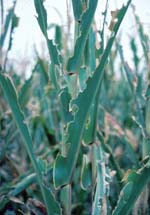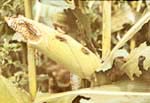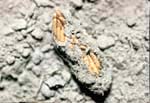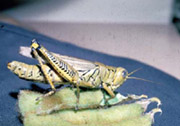Grasshoppers
Differential Grasshopper Melanoplus differentialis
Migratory Grasshopper Melanoplus bilituratus
Red-legged Grasshopper Melanoplus fermur-rubrum
Crickets Gryllid spp.
Long-horned Grasshoppers Tettigoniid spp.
Description
The differential grasshopper is the largest economically important
species. It is 1-1/2 to 1-3/4 inches long, yellowish, with brown and
black markings and distinct chevron-like black markings on the hind
legs. The adults of migratory and red-legged grasshoppers are about 1
inch long--reddish-brown above and yellow beneath, with red-tinged hind
legs. The nymphs are wingless, but otherwise resemble the adults. The
elongated, brown-to-orange eggs (glued together in masses) form a pod in
uncultivated soil,usually 1 to 2 inches below the surface. The
differential grasshoppers winter as eggs and do not appear as adults
until summer.

Figure 1. Meadow Grasshopper
Grasshoppers feed on nearly all cultivated and wild plants. The differential and red-legged grasshoppers prefer luxuriant vegetation, while the migratory grasshoppers prefer sparse vegetation. All three species are found throughout Illinois, but the migratory type is found in greatest numbers in the southern sections.
Life History
Injurious grasshoppers winter as eggs, which hatch from mid-May in
southern Illinois to July in northern Illinois. The nymphs shed their
skins several times, reaching maturity in 6 to 8 weeks. The adults
continue to feed until fall. when they mate and the female lays eggs.
During September and October, a single female will lay several egg pods
containing from 15 to 120 eggs. The eggs are deposited 1 to 2 inchess
belopw the soil surface in field margins, fencerows, ditch banks,
roadsides, and sod land. Hot, dry weather favors grasshopper
developmenr. In wet, humid weather, diseases (bacteria and fungi) kill
of many hoppers.

Figure 2. Grasshopper
Feeding Damage to Corn
Damage
Grasshoppers are chewing insects that feed from the outer edges of
leaves inward. When numerous on corn, they even eat part of the stalk
and ears. They attack fresh silks, reducing pollination and often
causing the ears to be blank or only partly filled. Even light
infestations of 6 or 7 grasshoppers per square yard in a 10-acre hay
field will eat as much hay as a cow; 17 hoppers per square yard in a
40-acre hay field will eat a ton of hay a day. All types of field crops,
vegetable crops, fruit crops, flowers, and shrubs are subject to
attack.

Figure 3. Grasshopper
Damage to Corn
Control
Grasshoppers have many natural enemies. Among the more-important ones
are flesh flies, bee flies, blister beetles, ground beetles, spiders,
hairworms, rodents, birds, and diseases.
Pests Related To Grasshoppers
Crickets differ from grasshoppers by having antennae about as long as
their bodies. They are dark-colored, except for the tree crickets which
are green. The females have a long, straight egg-laying tube. Some
species are winged, while others are wingless. Crickets make a
characteristic chirping sound, usually in unison. They feed mostly at
night on a variety of materials. Field crickets can be found nearly
everywhere in pastures and gardens, where they hide under stones,
leaves, and other objects on the ground or burrow into the soil. Most
crickets feed on plants, but some types are predaceous. Tree crickets
live among herbaceous and woody plants, and the females (with their
long, sturdy egg-laying tube) sometimes split open small branches and
cause serious damage. Other types include the soil-inhabiting mole
crickets, the ant-loving crickets and the bush crickets. Control of
crickets is rarely necessary under Illinois conditions
Long-horned Grasshoppers
These long-legged, jumping insects also differ from grasshoppers by
having long antennae. The females have a long, curved, nearly
sword-shaped, egg-laying tube that distinguishes them from crickets. All
katydids are green; crickets are dark brown to black, except for the
tree crickets. Both winged and wingless species occur. Katydids so
closely resemble grasshoppers they are often called long-horned
grasshoppers. They are found almost everywhere, but seldom in large
numbers. They feed at night on plants and small animals. Their
characteristic chirping sound is frequently heard. Control is rarely if
ever necessary.



Figure 4. Red-legged Grasshopper Figure 5. Grasshopper Egg Pod Figure 6. Differential Grasshopper